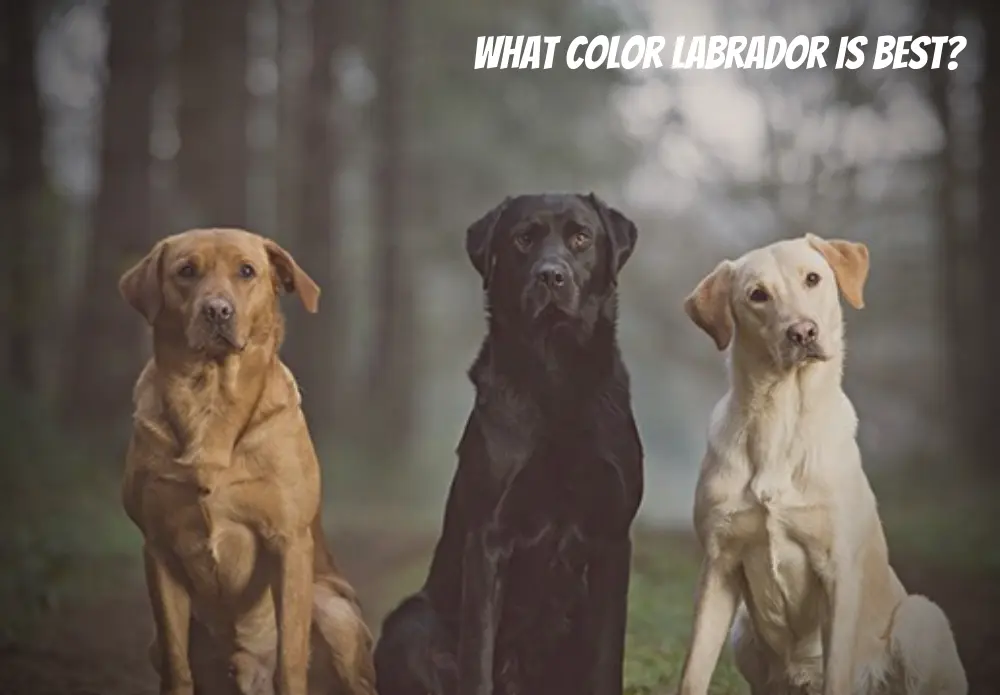How do you choose which color Lab to select when there are so many gorgeous Labrador Retrievers worldwide?
Breeders, trainers, and the American Kennel Club accept Labradors in three primary colors: black, yellow, and chocolate. Is there a certain color that is more intelligent, simple, or healthy than the others?
What Color Labrador is Best?
There isn’t just one Lab color that is the best, yet there are certain differences and strong opinions about each of the three colors.
Depending on your health or other variables, you might prefer a specific hue because each Lab color has somewhat different characteristics.
Remember that temperament and health are crucial; select the desired color based on breeding traits and personal preferences. Let’s discuss this in greater depth.
Do Labrador Dog Colors Matter?
The three different Labrador hues are frequently connected to various professions.
The black Labrador is often linked with hunting and retrieving activity, the yellow Labrador with pet homes, and the chocolate Labrador with the show ring.
However, these are merely generalizations, and in reality, Labradors of all colors have taken on all the varied responsibilities for which these extraordinary dogs are well-suited.
Labrador Colors and Their Characteristics
In addition to a wide range of color shades, Labradors has three main colors.
Fox Red Labradors
Officially, Fox Red Labradors belong to the Yellow Labrador breed, which is much more prevalent. These dogs often have coats that are more orange in color and are working breeds. On Kennel Club paperwork, they are still listed as yellow Labradors.
Yellow Labradors
Although highly renowned for many jobs, yellow labradors are arguably most known for their work as service dogs, they are loving, well-behaved, and simple to train.
The yellow Labrador can still make an excellent pet and be well-liked in the show ring despite being well-liked for highly trained jobs and being naturally attractive and commonly appearing in charitable literature.
The Dudley Lab is a distinct variety of yellow Labrador that lacks black pigmentation on its nose, eyelids, and mouth. On a Dudley Lab, such spots are pink rather than the more normal dark brown or black.
Yellow Labs are known for being playful, amiable, and outgoing. They are most frequently observed at work as service and emotional support animals.
The lifespan of a yellow lab can range from 11 to 14 years, comparable to that of a black lab. Of course, a dog’s breeding and parental history significantly impact its health.
Black Labradors
Although they also make fantastic pets, friends, and agility dogs, black labradors have traditionally been prized as gundogs.
Due to how their genes are passed, they are the most prevalent color of Labrador. Because of this, they may be underrated when it comes to people’s top choices for the finest Labrador color, but they are still truly fantastic dogs.
Black Labs typically live 11 to 14 years, which is about average for Labradors.
Being able to breed more carefully may produce dogs that are healthier in general. However, much of this depends on the breeder you are utilizing and the particular dogs’ traits and health.
Chocolate Labradors
In addition to participating in the show ring, chocolate labradors make wonderful home dogs. The hunting lines of chocolate Labradors are extremely well-established in America.
It is important to remember that Chocolate Labradors have only recently begun winning honors in the UK. At least on Field Trial circuits, black and yellow Labradors continue to dominate.
The least popular and most difficult to breed for the main Labrador Retriever color is chocolate. They have the undeserved reputation of being the most excitable, hyper, and energetic Lab.
Fawn Labradors
In recent years, fawn Labradors have occasionally been used to refer to yellow Labradors.
You might refer to your Lab puppy as a Fawn Labrador if his color is slightly darker than the typical yellow but not as orange as a Fox Red Labrador.
However, this color is not recognized by the Labrador breeders in the same way as Fox Red is now. It is also not an official Labrador color.
Silver Labradors
Silver Labrador breeding is a relatively new phenomenon. Labrador enthusiasts make many positive and negative remarks in response to this magnificent color.
The color difference in chocolate is caused by a gene that dilutes. It is unknown how this gene got into the breed, though.
Which is The Best Labrador Color for You?
While some people strongly like a certain color, others are perfectly content with either.
When selecting the ideal dog, you will have more options of Labrador breeders to include on your shortlist if you are not particular about color.
When choosing a puppy, consider your preferences carefully, even if you happen to have a favorite hue to look at. Your Labrador’s parents’ attitude, function, and health may be what matters most.
Show vs Field Bred Labradors
Whatever your preference, it’s important to remember that Labradors now come in two quite different varieties: show and field.
Selecting the proper sort of dog will probably be more important than selecting the appropriate color.
With some, one variety will be more available to you than the other. Additionally, certain varieties will give you more options for a particular color than others.
How Breeding & Temperament Influence Your Decision
In addition to color stereotypes of Labradors, which may or may not apply to your next dog, there is something more important to consider.
You can look at a dog’s breeding pedigree, parental history, and certain environmental elements that may influence it. Still, you can’t generalize about a dog based only on its hue.
Breeding and hereditary characteristics of the parent dogs are significantly more crucial in developing your dog’s unique personality and temperament than color.
You can have a peaceful black, yellow, or chocolate Lab or a hyperactive, incredibly energized version of all three colors. The subset colors also hold to this.
Our observations show that your dog’s personality and ease of ownership are determined by its breeding and temperament, not by color!
Make careful to question the breeder about the personalities displayed by the puppies from past litters (from the same parent dogs), as for the mother and father canines’ behavioral quirks and health difficulties.
Ask the breeder if you may speak with any of the owners of puppies from previous litters if personality and temperament are important to you to understand how those dogs will develop as adults.
Although it cannot guarantee you will receive the same personality, it might be a good sign. Ensure your breeder has evaluated the parent dogs for health issues and provided you with health certifications from a veterinarian.
FAQs – Frequently Asked Questions
What Color Labrador is Most Popular?
Of all the Lab colors, black is the most favored. Gundog dogs are frequently linked with this coat color. Over many generations, these puppies have been bred specifically for hunting. They work closely with their owners in the field because they genuinely want to serve them.
Which Color Labrador Lives the Longest?
According to a Canine Genetics and Epidemiology study, dogs with yellow or black coats live roughly 10% longer than their chocolate counterparts. While the average lifespan of all laboratories is around 12 years, the average age of chocolate labs was 10.7.
Does the color of the Labrador matter?
The nature and temperament of a Labrador are very little influenced by the color of its coat. It’s difficult to state definitively whether a red fox Labrador or a yellow Labrador can be distinguished, despite some Labrador owners swearing as much.
Conclusion
Labrador Retriever has no superior color over any other; they are all beautiful dogs. The key factors to consider are what color you prefer and which personality attributes fit you the best.
Remember that misconceptions about Labradors based on color aren’t necessarily accurate and that inherent characteristics like temperament and personality passed down through breeding are more likely to impact your relationship with your Lab than color would.
However, look for ailments known to affect Chocolate Labs more commonly.
Pick the Labrador color you adore and undertake extensive research on a breeder or rescue to identify the dog’s temperament and disposition that is the best overall match. It’s the best path to success and enjoyment for you and your new puppy.






